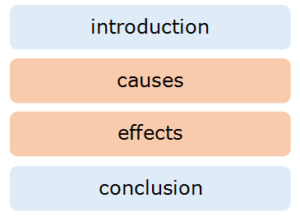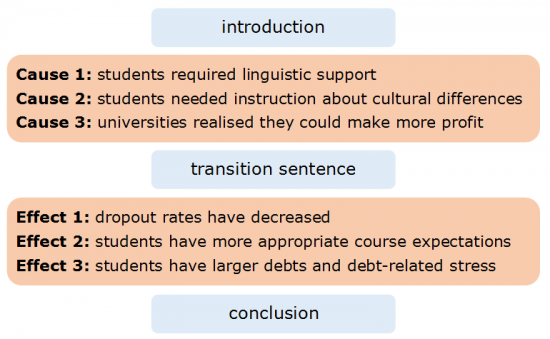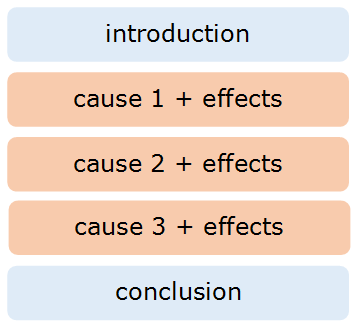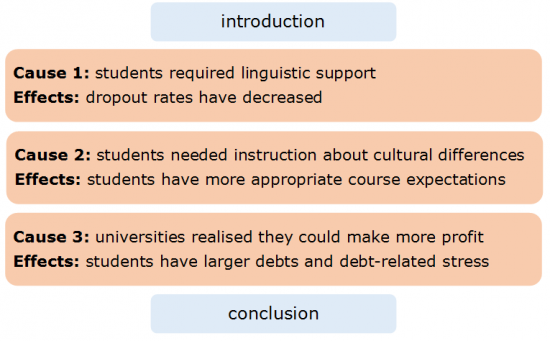What are some possible cause and effect essay structures?

This is the second of four chapters about Cause and Effect Essays. To complete this reader, read each chapter carefully and then unlock and complete our materials to check your understanding.
– Outline the two cause and effect essay structures
– Provide defining features of each structure
– Introduce a context to exemplify this essay type
Before you begin reading...
-
video and audio texts
-
knowledge checks and quizzes
-
skills practices, tasks and assignments
Chapter 2
As with many essay types, much of the structure of a cause and effect essay follows the traditional elements of introductions, body sections, and conclusions, such as the inclusion of background information, thesis statements, topic sentences and supporting details. However, there are two structural aspects of cause and effect essays that are more unique to this essay type, and are therefore worth mentioning here in some detail. To explore these two structures, let’s return to our previous example cause and effect essay question which focused on both the causes and the effects of the introduction of the preliminary year:

Structure 1: the Block Structure
Generally considered to be more appropriate for shorter cause and effect essays, or for those in which only the causes or the effects are the focus of that essay (but not both aspects), the block structure is when either the causes or the effects are grouped separately and are introduced in blocks:

With this structure type, there are three things to remember:
1. How many paragraphs the writer dedicates to the causes and to the effects is dependent upon the length of the essay and the writer’s choice.
2. It’s important to include a transitional sentence either at the end of one paragraph or the beginning of the next when moving the reader from discussing the causes to discussing the effects.
3. The effects may be described before the causes if such effects are the focus of the essay; otherwise, it’s generally considered to be more logical to always place the causes before the effects in a cause and effect essay.
Using our example essay question, a plan for a block-structured essay about preliminary-year programmes might contain the following ordering and main ideas:

Structure Two: the Point-by-Point Structure
Also known as chaining, a point-by-point structure is when a cause and effect essay is ordered so that each cause and its effects are dealt with together before moving on to the next cause. Such an ordering can be an efficient and logical way of structuring an essay of this type, particularly if your essay is quite long or if you’ve been asked to focus on both the causes and the effects of a topic.
Much like the block structure, it’s still considered logical however to order the causes before the effects, as is shown in the following diagram:

Using our essay question about preliminary-year programmes, an example plan for such a point-by-point cause and effect essay might look something like this:

Whichever structure you choose, don’t forget to include the usual essay writing elements and to make sure that your writing is clear, concise, logical and well edited. Remember also to utilise some of the language structures that we’ll be outlining in Chapter 3.
To reference this reader:
Academic Marker (2022) Cause and Effect Essays. Available at: https://academicmarker.com/essay-writing/essay-types/cause-and-effect-essays/ (Accessed: Date Month Year).
Downloadables
Once you’ve completed all four chapters about cause and effect essays, you might also wish to download our beginner, intermediate and advanced worksheets to test your progress or print for your students. These professional PDF worksheets can be easily accessed for only a few Academic Marks.
Collect Academic Marks
-
100 Marks for joining
-
25 Marks for daily e-learning
-
100-200 for feedback/testimonials
-
100-500 for referring your colleages/friends